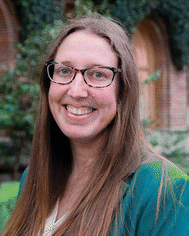Materials Horizons Emerging Investigator Series: Dr Megan Fieser, University of Southern California, USA
Megan Fieser earned her BA in chemistry from Washington University in St. Louis, where she worked with Professor Kevin Moeller. She then pursued her doctoral studies in chemistry at the University of California, Irvine, working with Professor William Evans. Her PhD research focused on spectroscopic and computational analysis of rare earth and actinide complexes in unusual coordination environments and oxidation states. Following the completion of her PhD, Megan conducted postdoctoral studies in the laboratory of Professor William Tolman at the University of Minnesota, Twin Cities, where she contributed to the NSF Center for Sustainable Polymers. She collaborated with Professors Geoffrey Coates and Christopher Cramer to gain insight into the catalytic mechanism of the perfectly alternating copolymerization of epoxides and cyclic anhydrides and to develop innovative catalytic methods for directed decarbonylation of fatty acid methyl esters (FAMEs).
In 2018, Megan joined the University of Southern California as a Gabilan Assistant Professor of Chemistry and faculty affiliate of the USC Wrigley Institute for Environment and Sustainability. Since then, she has established a robust research program focused on the development of catalysts to combat plastic (polymer) pollution. These catalysts are employed to produce degradable and/or recyclable polymer alternatives, as well as to convert commercial polymers to valuable molecules and polymers at the end of their life cycle. In addition to her laboratory research, Megan is dedicated to outreach and education. Her team organizes regular beach cleanups in Southern California and strives to educate the public about sustainable choices they can make as consumers.
Read Megan Fieser's Emerging Investigator Series article ‘Controlling selectivity for dechlorination of poly(vinyl chloride) with (xantphos)RhCl’ ( https://doi.org/10.1039/D2MH01293F ) and read more about her in the interview below:
MH: Your recent Materials Horizons Communication reports the use of a molecular inorganic catalyst to control the dechlorination reactivity of PVC to perform hydrodechlorination which forms polyethylene-like materials. How has your research evolved from your first article to this most recent article and where do you see your research going in future?
MF: My current research as an independent faculty member has been shaped by the valuable experiences I gained during my PhD and postdoc research. In my PhD, I acquired essential skills in synthesizing and characterizing highly reactive inorganic molecules. My postdoctoral training provided me with the expertise to conduct meticulous mechanistic studies on catalytic processes and develop innovative catalyst design principles using various metal catalysts. While these papers look quite different from my publications in my independent career, my current research relies heavily on the skills I acquired throughout my academic training. Our manuscript on PVC conversion was the first project we undertook in this exciting new direction. I vividly remember the day when a first-year graduate student, Nancy Bush, excitedly burst into my office to show me data supporting a polyethylene-like product! I think our work will continue to identify new catalytic methods that impact plastic sustainability in the foreseeable future.
MH: What aspect of your work are you most excited about at the moment?
MF: It is hard to identify a single favorite aspect of my research, as there are many aspects that I find exciting. However, one thing that has particularly energized me is my group's creativity in developing catalyst design principles that prioritize simplicity. This basic idea has taken our research in directions I never expected.
MH: In your opinion, what are the most important questions to be asked/answered in this field of research?
MF: In my view, addressing issues related to topics of environmental sustainability is crucial. From plastic pollution to climate change, there are numerous targets to address that could impact the environment and our future. To truly achieve meaningful and practical solutions, a multidisciplinary approach is essential, drawing on expertise on topics ranging from business, chemistry, environmental science, engineering and politics.
MH: What do you find most challenging about your research?
MF: One of the biggest challenges we face when working to convert commercial polymer products to new molecules and polymers is accounting for all the possible additives that may be present in the recycling stream. It can be difficult to identify what additives are present in a product and which ones may impact the catalytic process. However, I find this aspect of our work to be an interesting component as it pushes us to consider a range of factors when we design our methods.
MH: In which upcoming conferences or events may our readers meet you?
MF: I will be visiting many universities in the UK and US over the next 8 months or so. Additionally, you can find me at the Canadian Chemistry Conference and Exhibition in Vancouver, ACS Green Chemistry and Engineering Conference in California, and Plastics Recycling and Upcycling Gordon Research Conference in New Hampshire this summer.
MH: How do you spend your spare time?
SB: I like to spend as much time outside in Southern California as I can, often walking my dog, Riley. I spend most of my spare time exercising (walking, running, biking and rowing) and spending time with all my rescue animals (two dogs and two cats). I have also been crocheting since I was six years old, so making blankets, hats, scarves and oven hot pads are a great way for me to decompress.
MH: Can you share one piece of career-related advice or wisdom with other early career scientists?
SB: The best advice I can give is to communicate your dreams and goals with the mentors around you. If they know what you want in your future career, they can be much better prepared to help you achieve these goals.
| This journal is © The Royal Society of Chemistry 2023 |

